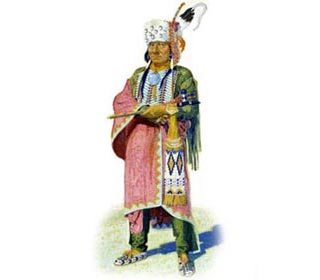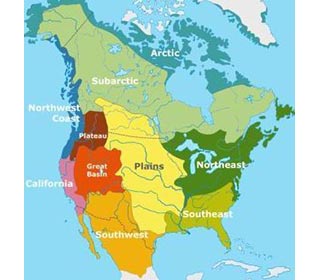What did the Arapaho tribe live in?
The Arapaho tribe lived in tent-like homes called tepees. Tepees were constructed from wooden poles that were covered with weather-proof animal skins such as buffalo hides. The tepee was cone shaped, with flaps for entrances, rounded at the base and narrowed to an open smoke hole at the top. The inside of the Tepees had limited furnishings. Buffalo hides were used for seating, covers and bedding. A hearth was built in the center of the tepee for cooking and heating. Most tepees were approximately 12 - 16 feet in diameter at the base. The tepee suited the nomadic lifestyle of the Arapaho tribe as it was quick to erect and easy to dismantle. The Arapaho tribe moved from place to place using sleds, called travois, that were pulled by dogs or horses. What language did the Arapaho tribe speak?
The Arapaho tribe spoke in the Algonquian language. What did the Arapaho tribe eat?
The mainstay of the food that the Arapaho tribe ate included the meat from all the native animals that were available to hunt including the buffalo, deer, elk, bear and wild turkey. These meats were supplemented with roots, herbs and wild vegetables such as spinach, prairie turnips and potatoes. Wild berries and fruits were also added to the food resources available to the Arapaho. When food was scarce the Arapaho tribe ate dried buffalo meat, called pemmican. What weapons did the Arapaho use?
The weapons used by the Arapahos included bows and arrows, stone ball clubs, jaw bone clubs, hatchet axe, spears, lances and knives. Painted war shields were used on horseback as a means of defence. The rifle was added to their weapons with the advent of the white invaders. Arapaho Clothing
The women of the Arapaho tribe were responsible for making the clothes worn by the people. Most garments were sewn from soft, tanned skins of deer (buckskin) and buffalo. Clothing was often decorated with paint, porcupine quills or beadwork. Arapaho clothing for both men and women were adorned with ornaments, especially necklaces and armbands. What clothes did the Arapaho men wear?
The clothes worn by the Arapaho men consisted of breechcloths, fringed buckskin tunics or shirts and leggings. Warm buffalo robes or cloaks were also worn to protect against the rain and the cold. The adult Arapaho men also wore beaded, straight-up feathered war bonnets decorated with eagle feathers and beadwork as a symbol of courage and accomplishment. Arapaho men wore war paint in times of conflict and used paint also for religious ceremonies. What clothes did the Arapaho women wear?
The type of clothes worn by the Arapaho women were knee-length dresses and leggings. The women also wore the buffalo robes to keep warm and dry. The dresses of the Arapaho women that were used for special ceremonies were intricately decorated with beads. Dresses were also painted with symbols that reflected their tribal identity and family values celebrating acts of courage by their men or sacrifices made for the well-being of the family and tribe. Arapaho women wore their hair long worn in two, thick braids decorated with beads. What was the religion and beliefs of the Arapaho tribe?
The religion and beliefs of the Arapaho tribe was based on Animism that encompassed the spiritual or religious idea that the universe and all natural objects animals, plants, trees, rivers, mountains rocks etc have souls or spirits. The Great Plains tribes such as the Arapaho believed in Manitou, the Great Spirit. What were the rituals and ceremonies of the Arapaho tribe?
The rituals of the Arapaho tribe included the smudging rituals, the Sweat Lodge ceremony, the Vision Quest and the Sun Dance Ceremony. The sacred, ceremonial pipe (called a Calumet), was ritually filled with tobacco was passed among participants at all sacred ceremonies of the Arapaho. The Calumet, was often used to seal a peace treaty, hence the term 'Peace Pipe', but it was also used to offer prayers in religious ceremonies and in war councils. Who were the most famous leaders and chiefs of the Arapaho tribe?
The most famous leaders and chiefs of the Arapaho tribe included Niwot (aka Chief Left Hand), Hosa (aka Little Raven) and Chief Sharp Nose. There were constant battles between the different tribes of the Plains and the Arapaho eventually made an alliance with the the Sioux and the Comanche. The Arapaho supported their allies during the great Sioux Wars and fought against the US army during the Battle of the Little Bighorn. Arapaho History Timeline: What happened to the Arapaho tribe?
The following history timeline details facts, dates and famous landmarks and battles fought by the Arapaho Nation. The timeline explains exactly what happened to the Arapaho tribe. The Arapaho have originally formed a single tribe with the Gros Ventre. Arapaho History Timeline 1600s: The Arapaho once resided together to the east near the Great Lakes or farther north in Canada 1700's: The Arapaho moved south, acquired horses and adopted a nomadic lifestyle using tepees and moved to the Great Plains regions when the tribe split up into the Northern and Southern Arapaho 1800's: Alliance formed with the Sioux and Cheyenne tribes 1854: The Sioux Wars (1854 - 1890)in South Dakota, Minnesota and Wyoming - a fight to keep their homelands 1851: First Treaty at Fort Laramie 1850: Chief Niwot, meaning Left Hand became chief of the Southern Arapaho tribe 1861: Treaty of Fort Wise offered the tribe a small portion of land in eastern Colorado - The Arapaho refused to sign the treaty 1864: Sand Creek Massacre. Chivington's massacre of the Arapaho at Sand Creek in 1864 1865: 1,000 warriors of the alliance attack the town of Julesburg in retaliation to the Sand Creek massacre 1865: Powder River Expedition 1865: Red Cloud's War (1865–1868) 1866: Fetterman Fight on December 21, 1866 1867: The Southern Arapaho were moved onto a reservation in Indian Territory (Oklahoma). The northern Arapaho continued fighting 1868: The 1868 Fort Laramie Treaty the US army agreed to abandon the posts along the Bozeman Trail 1875: Gold discovered in Native Indian lands 1875: Indian agents were directed to move off-reservation Native Indians to report to their agencies leading to violent conflict 1876: The Buffalo War - Buffalo are wantonly slaughtered all over the Great Plains (over 65 million were destroyed by white hunters) depriving the Native Indians of their means to live 1876: Battle of Powder River on March 17, 1876 1876: The Battle of the Rosebud on June 17, 1876 1876: The Battle of the Little Bighorn on June 25 1876 against George Custer and the 7th Cavalry 1876: The Arapaho Dispersal (1876 - 1878) 1878: Arapahos forced to move onto the Wind River Reservation in Wyoming 1890: The last Northern Arapaho conflict with the US Cavalry was during Wovoka's Ghost Dance Turmoil
Arapaho History Timeline Arapaho History Timeline: What happened to the Arapaho tribe?
The Southern Arapaho now live in west-central Oklahoma near the Canadian and North Canadian rivers. The Northern Arapaho Tribe holds joint sovereignty with the Eastern Shoshone Tribe over the Wind River Indian Reservation in Wyoming. | 
